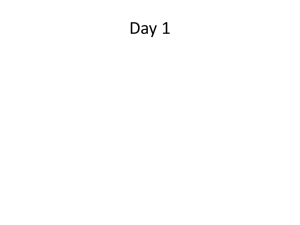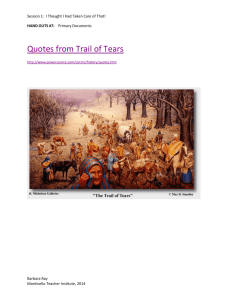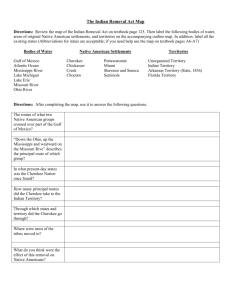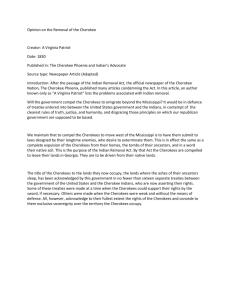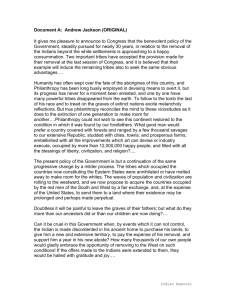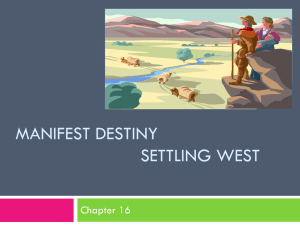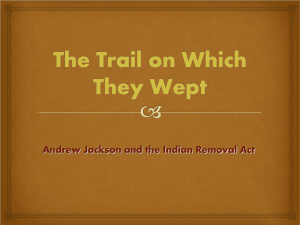Indian Removal
advertisement
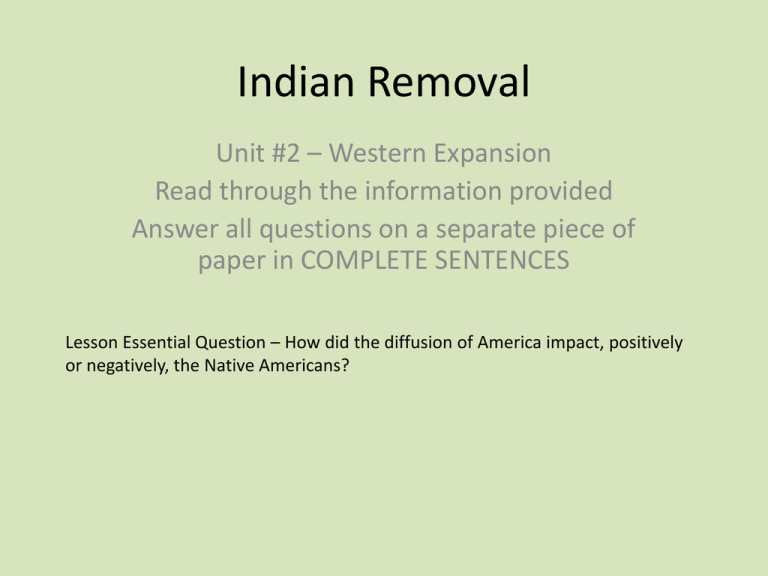
Indian Removal Unit #2 – Western Expansion Read through the information provided Answer all questions on a separate piece of paper in COMPLETE SENTENCES Lesson Essential Question – How did the diffusion of America impact, positively or negatively, the Native Americans? Indian Peace Medals Indian Peace medals were produced by the United States government and given to Indian leaders in the course of our nation’s negotiations with the multitude of tribes that owned the land coveted by the national and state governments. It is interesting to study the different designs of these peace medals are they evolved. Dr. Jack Campisi states: Nearly every president from George Washington through Benjamin Harrison had medals issued with his likeness engraved on the front or obverse side; however, it is the reverse side that draws our interest. Here was emblazoned in pewter, bronze, or silver the central justification for our nation’s policy toward Indian tribes. This policy contrasted a EuroAmerican definition of civilization with a perceived Native condition of savagery. The components of this perception are presented on the medals in bas relief as bipolar: agriculture versus hunting, settlement versus nomadism, war versus peace, and ultimately assimilation versus tribalism. Peace Medals George Washington Indian Peace Medal - Red Jacket smoking long pipe, George Washington on left with right hand extended James Monroe Indian Peace Medal • Explain the difference between the reverse side of the two peace medals. Indian Removal Policy "The evil, Sir, is enormous; the inevitable suffering incalculable. Do not stain the fair fame of the country. . . . Nations of dependent Indians, against their will, under color of law, are driven from their homes into the wilderness. You cannot explain it; you cannot reason it away. . . . Our friends will view this measure with sorrow, and our enemies alone with joy. And we ourselves, Sir, when the interests and passions of the day are past, shall look back upon it, I fear, with self-reproach, and a regret as bitter as unavailing." Edward Everett, "Speeches on the Passage of the Bill for the Removal of the Indians Delivered in the Congress of the United States" Indian Tribes Map Key: 1. Seminole 2. Creek 3. Choctaw 4. Chickasaw 5. Cherokee 6. Quapaw 7. Osage 8. Illinois Confederation Indian Removal Policy Answer for map on previous slide 1. Even after ceding, or yielding, millions of acres of their territory through a succession of treaties with the British and then the U.S. government, the Cherokees in the 1820s still occupied parts of the homelands they had lived in for hundreds of years. What modern states are included within the boundaries of the Cherokee Nation? How large is the territory compared with the modern states? 2. What other tribes lived near the Cherokees? Whites often referred to the Cherokee, Chickasaw, Choctaw, Creek, and Seminole as the "Five Civilized Tribes." What do you think whites meant by "civilized?" President Andrew Jackson • President Andrew Jackson defended Indian Removal in his first, second, and seventh annual address. Read through the annual addresses listed below. Did his opinion change between 1829 and 1834? Why or why not? Cite specific examples. – First Annual Address (1829) – Second Annual Address (1830) – Fifth Annual Address (1833) – Sixth Annual Address (18340 Chief John Ross on Relocation • Chief John Ross and other leaders of the Cherokee nation wrote a letter to Congress to protest the 1835 Treaty of New Echota. This treaty, signed by a group of Cherokees claiming to represent their people, stated that the tribe would relocate west of the Mississippi. The majority of Cherokees, over 15,000, opposed the treaty. • Read Ross’ letter. In this letter, Chief Ross and the others state the case for the Cherokee majority. • Make a case for the Cherokee Tribe to not be relocated. Cite specific examples. Political Cartoon • Answer the following three questions for the political cartoon – 1. What is going on in this picture? (1 point) 2. Who or what is represented by each part of the drawing? (1 Point) 3. What point is the cartoonist making? (3 Points) The Human Meaning of Indian Removal What went wrong on the Trail of Tears? This photo shows a segment of road believed to have been used during the Cherokee removal of 1838. The Human Meaning of Removal • Compare General Winfield Scott's letter and general order, statements about what should have happened, with Private John G. Burnett's narrative of what he saw. Since soldiers did not, routinely ignore general orders, the vast discrepancy between these primary sources calls Scott's sincerity into serious question. The fact that the army did not investigate what happened also suggests that the general order was never supposed to be taken literally. – General Winfield Scott – Private John G. Burnett Cherokee Removal Routes – Trail of Tears Map Questions for the Trail of Tears Map 1. How many different routes are shown? Why do you think there might have been so many? 2. Find the water route. What rivers does it follow? What advantages to you think it might have over an overland route? What difficulties might it present? 3. Locate the land route. How does it compare with the other main routes? What major rivers did it cross? What advantages and what disadvantages might the Land Route have? 4. The largest group of Cherokees followed the land route. They left Tennessee in the late fall of 1838 and arrived in Indian Territory in March. What problems do you think they might have encountered on the journey? The Human Meaning of Removal • Read the following documents and describe the hardships and dislocations that the Indians faced along the Trail of Tears. Cite specific examples – Eliza Whitmire – Elizabeth Watts – Lt. L. B. Webster – Jane Bushyhead EXIT TICKET The Diffusion of the Cherokee • Study the maps that follow to complete the following on an index card – – Create a definition for the term DIFFUSION – What patterns do you see in the maps? How do they represent the term DIFFUSION?
